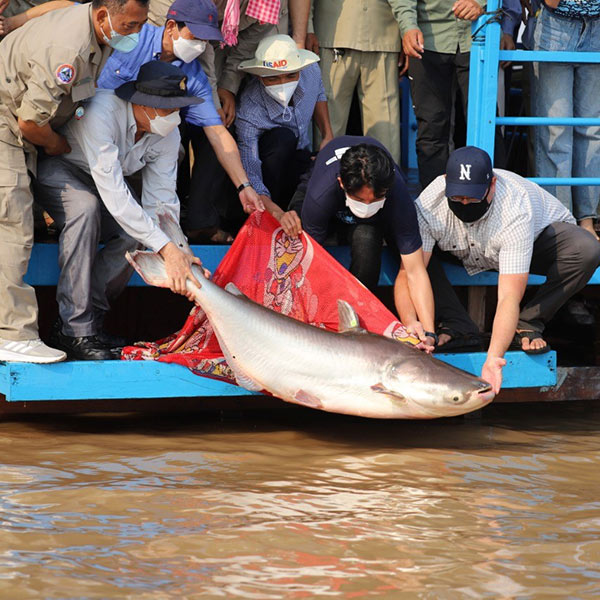Water is arguably the planet’s most valuable resource. Water supports crops, maintains ecosystems and provides a place to both work and play. It is a building block of life as we know it. The importance of water can’t be understated, which is why researchers at the University collaborate through the Global Water Center to better understand and protect it. From the University’s backyard to a river basin in Cambodia, the research happening within the Global Water Center is truly international and provides important policy information to those who make decisions about the precious resource.
Jewel of the Sierra
Researchers from the University study water systems and lakes around the world, but one lake holds a special place in their hearts: Lake Tahoe. The alpine lake is known worldwide for its clarity. But that clarity is at risk.
In 2018, six wildfires left smoke hanging over Castle Lake in Northern California. Researchers from the Global Water Center deployed monitoring equipment at Castle Lake and found that the lake changed substantially after the smoke.
When the devastating Caldor Fire broke out and began to burn significant swaths of forestland around Lake Tahoe, researchers didn’t hesitate to deploy monitoring equipment. Castle Lake acts as a good analog to Tahoe, so the researchers knew they needed to get the equipment deployed at Tahoe quickly, fundraising for the project as they worked. Support came from numerous universities and organizations.
“It takes a science village to save a lake," Sudeep Chandra, Director of the Global Water Center and biology professor, said.
As fires become more frequent and intense throughout the West, the impacts of the fires on lakes like Castle Lake and Lake Tahoe will be important to monitor and understand to inform policy. Those policy changes may look like implementing regional fire management plans that span states to protect Tahoe from smoke and ash.
Rising temperatures decrease water supply
Despite some heavy winter storms, the West is still in an extended period of drought, and the consequences extend along the entirety of the Colorado River. In a series of blog posts about the drought and falling water supply, three University professors provide insight into potential solutions.
Nevada State Climatologist and Associate Professor of Geography Steph McAfee wrote about how temperatures in the West are impacting water levels in the Colorado River. While drought isn’t unusual for the region, even centuries before stream gauges measured water flow in the river, the higher temperatures the region has experienced over the past two decades have been unusual and have had significant impacts. Water levels in Lake Mead, which serve as the indicator of water supply, are projected to drop to 1,075 feet.
As a result of the decreased water supply, the federal government declared a Tier 1 water shortage, and southern Nevada water allocations will be reduced by 7%. These drastic reductions call for creative solutions, like using reclaimed water at parks and golf courses. Reclaimed water will be a valuable alternative to the typical water sources, wrote Kerri Jean Ormerod, an associate professor in geography. She wrote that the $1.2 trillion infrastructure package recently passed by Congress has significant funding for improving water infrastructure.
For now, the shortages will mean that water will be allocated according to the Drought Contingency Plan, a series of guidelines adopted by seven states that are dependent on the Colorado River. Elizabeth Koebele, an assistant professor of political science, and her research team is studying how the Drought Contingency Plan will be renegotiated with more severe impacts from climate change facing Nevada and the region.
Impacts of the Global Water Center
Over the course of six years, the Global Water Center’s reach and impact has been extensive. The Center has done work in dozens of locations, including Mongolia, Antarctica, Chile and Italy, and its faculty have done research on every continent. Zeb Hogan, conservation biologist and host of the National Geographic Wild show “Monster Fish,” has worked closely with Global Water Center Director Chandra for over a decade. Hogan and Chandra make a point to immerse themselves in the cultures of whatever country they are working in to better understand the culture and how people depend on the water systems around them.

Hogan recently led a fish release of over 1,500 fish into a fish reserve in the Tonle Sap Lake in Cambodia. The team of people Hogan worked with included project staff for the Wonders of the Mekong project, students, post-docs and faculty from local universities, environmental rangers and military and police officers. The fish release is part of a research project that aims to understand whether fish reserves are an effective method for supporting endangered fish, and the findings will inform future decisions about endangered fish conservation.
The Wonders of the Mekong project is just one project out of the Global Water Center and serves as an excellent example of how important the research coming out of the center is. The Global Water Center's mission is to "translate science into actionable solutions accessible to stakeholders; develop a multidisciplinary, cooperative effort to solve water issues; and create novel, "high tech" tools (drones and models) to predict future conditions of water resources," and the work being done certainly achieves that mission.














